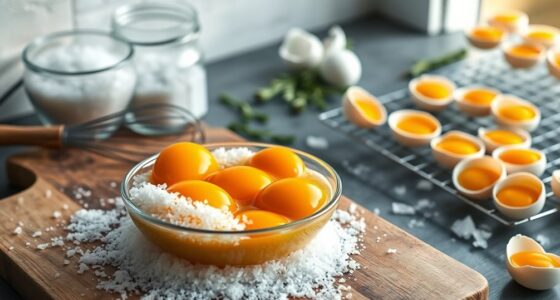Fontina cheese hails from the Italian Alps, where its creamy, nutty flavor and semi-hard texture make it a culinary favorite. This PDO product is made from the milk of Valdostana cows grazing in alpine pastures. Whether you choose the younger variety for fondue or the aged for grating, it elevates your dishes with its rich taste. Explore classic recipes like Fonduta alla Valdostana and discover tips for the perfect preparation and storage to enjoy every bite.
History

Fontina cheese has a rich history that dates back to the 12th century, rooted in the picturesque Aosta Valley of the Italian Alps.
Fontina cheese, with origins in the 12th century, embodies the rich heritage of the Aosta Valley in the Italian Alps.
This distinctive cheese originates from the milk of red-pied Valdostana cows, which roam the lush alpine pastures. The region's unique climate and grazing conditions contribute to the cheese's exceptional flavor profile, characterized by rich, nutty, and truffle-like notes.
Fontina gained recognition as a Protected Designation of Origin (PDO) product, ensuring its quality and adherence to traditional production methods.
However, in 1986, the U.S. Trademark Trial and Appeal Board ruled Fontina as a generic cheese name, leading to the emergence of similar cheeses outside the Aosta Valley, though they often fall short of its authentic taste and quality.
Recipe
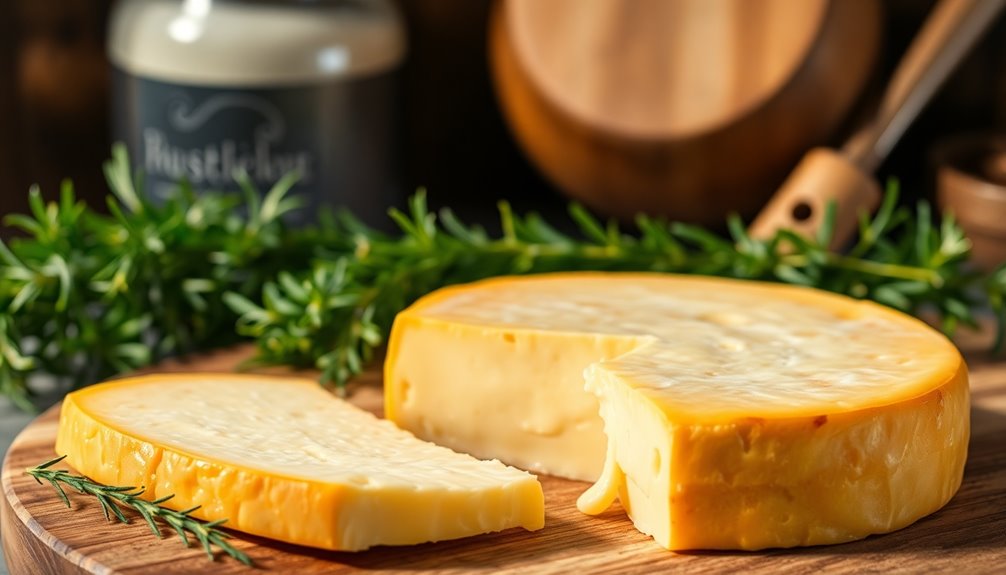
Fonduta alla Valdostana is a traditional Italian dish that showcases the rich, creamy texture of Young Fontina cheese. This delightful fondue is perfect for any gathering, allowing guests to dip a variety of accompaniments while enjoying the luxurious flavors of melted cheese. The combination of Young Fontina, milk, eggs, and truffles creates a decadent experience, transporting you to the rustic mountains of the Aosta Valley.
Whether served as an appetizer or a main course alongside crusty bread, this dish is sure to impress. To make this indulgent dish even more special, consider pairing it with seasonal vegetables or artisanal bread for dipping. The key to a successful fonduta is to ensure that your cheese is melted to a smooth consistency, so patience is essential.
The addition of truffles elevates the dish, bringing an earthy aroma that complements the richness of the cheese beautifully. Gather your ingredients and get ready to create a comforting and delicious dish that will be a hit with family and friends.
Ingredients:
- 300g Young Fontina cheese
- 200ml whole milk
- 3 large eggs
- 50g truffle shavings (or truffle oil)
- Salt, to taste
- Freshly ground black pepper, to taste
- Crusty bread, for serving
- Seasonal vegetables, for dipping (optional)
Instructions:
Begin by cutting the Young Fontina cheese into small cubes and placing it in a saucepan over low heat. Gradually add the whole milk, stirring continuously until the cheese is fully melted and the mixture is smooth.
In a separate bowl, whisk together the eggs, salt, and freshly ground black pepper. Once the cheese is melted, slowly incorporate the egg mixture into the saucepan, stirring constantly to avoid scrambling the eggs. Continue to cook over low heat until the fonduta thickens slightly.
Finally, fold in the truffle shavings or drizzle with truffle oil before removing from heat.
Extra Tips:
For the best flavor, ensure that your Young Fontina cheese is at room temperature before melting, as this will help it to melt more evenly. If you prefer a slightly thicker consistency, you can adjust the amount of milk used.
Additionally, feel free to experiment with different dipping options like roasted potatoes, sautéed mushrooms, or grilled meats to complement the rich and creamy fonduta. Enjoy the experience of sharing this warm and savory dish with loved ones!
Cooking Steps

To start cooking with Fontina, you'll first want to gather all your ingredients.
Once you've got everything ready, preheat your oven to 350°F to ensure even cooking.
Now you're set to mix the cheese with seasonings and get creative!
Step 1. Gather All Ingredients Needed

When you're ready to create a delicious dish featuring Fontina cheese, it's essential to gather all the right ingredients first.
For a traditional fondue, you'll need young Fontina cheese, made from unpasteurized milk, along with milk, eggs, and fresh truffles to enhance the flavors.
If you're opting for a classic Italian Fonduta alla valdostana, high-quality Fontina from the Aosta Valley, butter, and more truffles are a must.
For dishes using aged Fontina, prepare pasta, vegetables, or meats to bring out its nutty and savory notes.
Don't forget to pair your creation with Nebbiolo wine to complement the creamy texture.
Finally, ensure you have a good cheese knife and serving board ready for a perfect presentation of your table cheese.
Step 2. Preheat Oven to 350°F
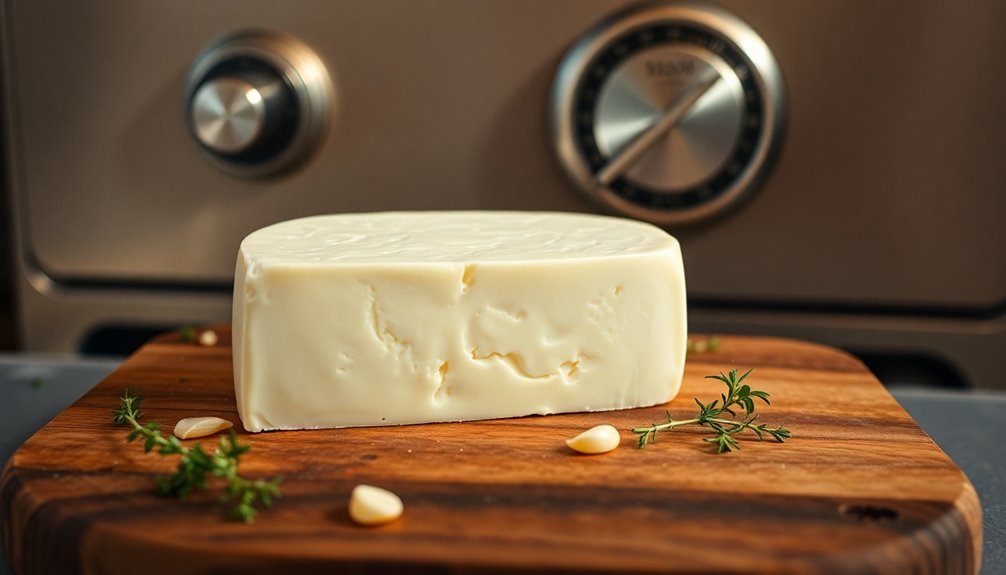
Preheating your oven to 350°F is crucial for achieving the perfect cooking temperature, especially for dishes that feature Fontina cheese. This step ensures even baking, allowing the cheese to melt beautifully while developing a golden crust.
Make sure to preheat your oven for at least 10-15 minutes before placing your dish inside. This way, you guarantee consistent heat distribution throughout the cooking process.
Whether you're preparing baked pasta, gratins, or casseroles, this temperature is ideal for bringing out the rich flavors of Fontina cheese.
To ensure accuracy, always use an oven thermometer; it'll help verify that your oven is truly at the right temperature. This simple action can make all the difference in your dish's final outcome.
Step 3. Mix Cheese With Seasonings

Once your oven reaches the perfect temperature, it's time to enhance the flavor of Fontina cheese by mixing it with seasonings.
Start by combining Fontina with garlic powder, black pepper, or fresh herbs like thyme and rosemary to elevate its creamy, nutty profile.
If you're after a savory twist, drizzle in some truffle oil or fold in finely chopped truffles, which beautifully complement the cheese's earthy notes.
For a bit of heat, consider adding paprika or cayenne pepper; these spices work wonders in fondues or cheese sauces.
To create a richer blend, mix Fontina with grated Parmesan or aged cheddar.
Lastly, for a smooth cheese dip, combine melted Fontina with cream cheese or sour cream and your chosen seasonings.
Step 4. Add Cheese to Baking Dish
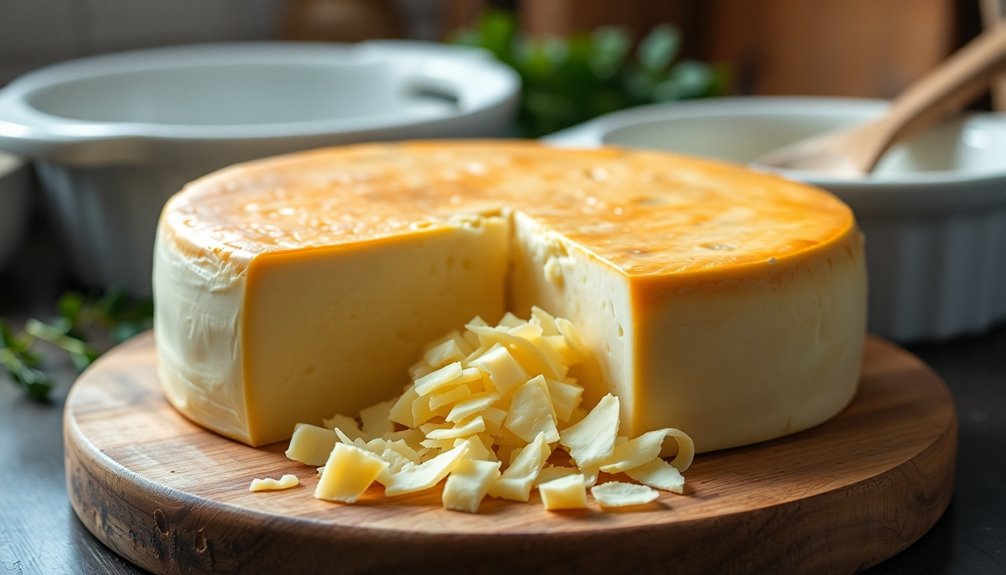
To get started with adding Fontina cheese to your baking dish, make sure it's at room temperature to ensure optimal melting.
This cow's milk cheese has a softer texture that makes it perfect for blending with other ingredients. Grate or slice the Fontina to enhance its melting properties and distribute it evenly.
You can incorporate it into creamy sauces or pasta bakes, where its nutty and savory flavor shines. For even more complexity, mix Fontina with other cheeses like aged cheddar or Gruyère. Additionally, proper storage methods for cheese can help maintain its quality and flavor over time.
Lastly, ensure your oven is preheated to around 350°F (175°C) before adding the dish, as this helps achieve that perfectly melted layer of Fontina you're aiming for.
Enjoy the rich flavors!
Step 5. Bake Until Golden Brown
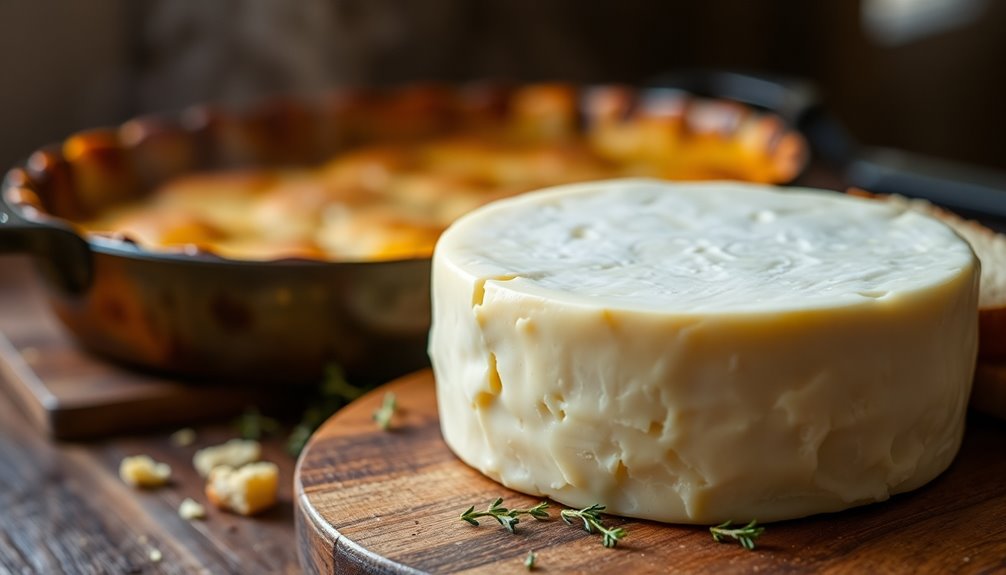
As your baking dish with Fontina cheese cooks, make sure to keep an eye on it to achieve that perfect golden brown crust.
Start by preheating your oven to 350°F (175°C). This temperature allows the cheese to melt and bubble beautifully without burning.
For an extra touch, sprinkle some breadcrumbs or grated Parmesan on top of the Fontina before you bake it.
Keep track of the cheese's temperature; it should reach at least 165°F (74°C) to ensure it's fully melted and safe to eat.
In the final minutes of baking, watch closely to prevent over-browning, since Fontina can quickly go from golden to burnt.
Enjoy the delicious results of your perfectly baked cheese!
Final Thoughts
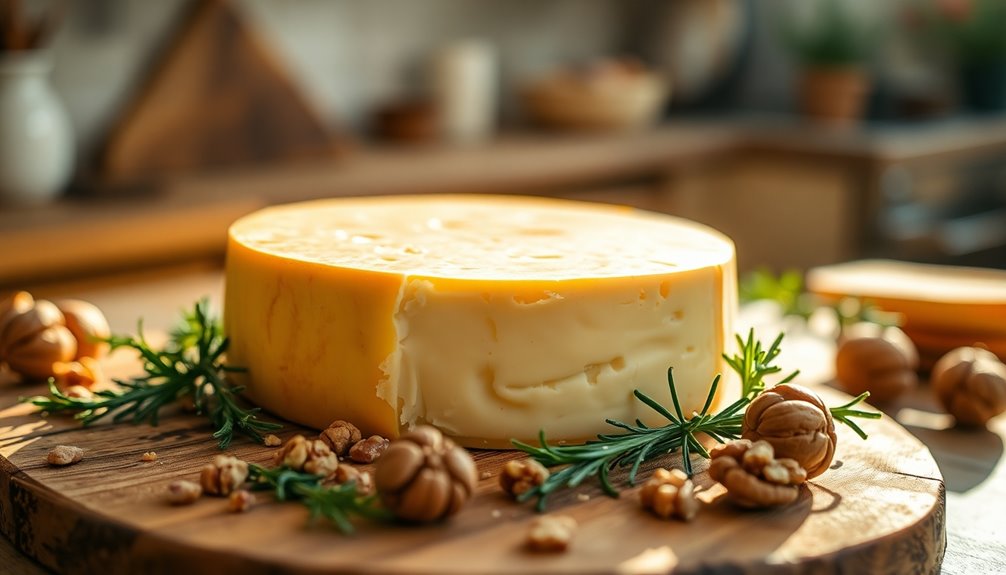
Though Fontina cheese may seem simple at first glance, its rich history and diverse flavor profiles reveal a complexity that can elevate any dish.
This premium cheese, hailing from the Valle d'Aosta in Italy, boasts a creamy, nutty flavor and semi-hard texture that makes it incredibly versatile.
Whether you're enjoying younger varieties in a delicious fondue or using aged Fontina for grating atop your favorite pasta, its distinct taste enhances your culinary creations.
Remember, proper storage is key; young Fontina lasts about two weeks in the fridge, while aged varieties can be frozen for up to a year.
Frequently Asked Questions
What Is Fontina Cheese Similar To?
Did you know that over 90% of cheese varieties melt well, making them perfect for cooking?
When you think about cheeses similar to Fontina, consider Gruyère for its nutty flavor and melting quality.
Taleggio's creamy texture and mild taste also come to mind, though it's a bit more pungent.
Havarti offers a softer, sweeter alternative, while Emmental is great for its holes and versatility.
Aged Gouda can provide that rich, caramel-like experience too.
What Is the Flavor of Fontina Cheese?
When you taste it, you'll notice a creamy, mild flavor that deepens with age.
As it matures, you'll experience nutty and savory notes that enhance your dishes.
The authentic varieties can surprise you with sweet and pungent hints, reminiscent of butter and roasted nuts.
If you try different versions, you might find some are milder and softer, but the richer flavors are definitely worth seeking out for your culinary adventures.
Is Fontina Cheese Good in Mac and Cheese?
Absolutely, using it in mac and cheese takes your dish to a whole new level!
It melts beautifully, creating a creamy, rich sauce that coats every bite. You'll love the nutty and savory flavors it brings, enhancing the overall taste.
If you mix it with other cheeses, like cheddar or Gruyère, you'll discover a more complex and satisfying flavor profile.
Trust me, it'll elevate your mac and cheese experience!
What Is Fontina Cheese Best Used For?
When it comes to versatile ingredients, you can't go wrong with a certain creamy delight.
You'll find it shines in decadent dishes, melting beautifully in fondue or enriching your pasta with a velvety sauce.
It also elevates casseroles and soups, lending them a luxurious texture.
Enjoy it on a cheese platter with fruits and crackers or grated over pizzas for a savory finish.
Its adaptability makes it a true culinary gem.





